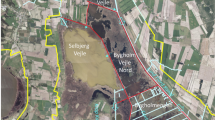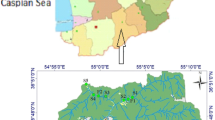Abstract
The largest natural lake in France, Grand-Lieu, has suffered eutrophication. The objective of the study was to estimate the annual input of nutrients (N, P) resulting from avian excrement, deposited by birds feeding out of the lake and returning to its waters for breeding or roosting, as compared to the input by the rivers that enter in the lake. Two years are compared: 1981–82 and 1990–91. About 1600–2000 breeding herons and cormorants, 20 000–33 000 wintering ducks, gulls and cormorants and 1–2.4 million starlings deposited about 5800 kg total N in 1981–82 and 7640 kg in 1990–91. Respectively, 2000 and 2530 kg total P were deposited over the same time periods. These represent 0.7% and 0.4% of the total N input of the lake and 2.4 and 6.6% of the total P input in 1981–82 and 1990–91. Starlings account for 74% of the N and mallards most of the rest. P input by starlings (36% in 1981–82, 41% in 1990–91), and by mallards and herons (35% and 27% in 1981–82 and 22% and 24% in 1990–91 respectively) plays an appreciable role among birds. During the plant growing period (April–September), the contribution by birds can increase to 37% of total P input of the lake. Piscivorous bird colonies concentrate Phosphorus 42 times more within the colony than outside the colony. Overall, the role birds play in total N and P input is relatively small due to very high inputs from human sewage and agriculture run off. The monthly mean concentration of the water of the two rivers reaches currently 10 mg l−1 of N (to 23 mg during peak floods) and 394 mg m−3 of P (to 468 mg during peak floods). Earlier, for example in the 1960's, water in Brittany only contained 0.1 to 1.1 mg 1−1 of N and 1 to 5 mg m−3 of P during the maximum flow period. At this time, birds could probably have represented annually up to 37% of the N input and up to 95% of the P input to the lake.
Résumé
Le plus grand lac de plaine français, Grand-Lieu, est actuellement largement eutrophisé. Le but de cette étude est d'estimer l'importation annuelle de N et P par les fientes des oiseaux qui s'alimentent à l'extérieur du lac, et de la comparer avec les apports des rivières alimentant le lac. Deux années sont comparées: 1981–82 et 1990–91. Les populations nicheuses (jusqu'à 956 couples de hérons cendrés et 136 couples de grands cormorans et 30 000 canards) et hivernantes (jusqu'à 17 000 canards, 1100 grands cormorans, 15 000 goélands et 2,4 millions d'étourneaux) ont respectivement importé 5800 kg de N total en 1981–82 et 7640 en 1990–91, soit 0,7% et 0,4% des entrées totales du système, et 2000 à 2530 kg de P total soit 2,4 et 6,6% des entrées. Les étourneaux sont responsables des trois quarts des apports d'azote par les oiseaux, et les canards de l'essentiel du reste, tandis que la part des étourneaux baisse pour le phosphore (36% en 1981–82 et 41% en 1990–91), au profit des Canards et des Hérons (respectivement 35% et 27% en 1981–82, 22% et 24% en 1990–91). Mais pendant la phase de croissance végétale (avril–septembre), la part des oiseaux monte jusqu'à 37% des entrées totales de phosphore. L'action localisée des colonies d'oiseaux piscivores est significative, avec une teneur de phosphore 42 fois plus grande dans l'eau sous la colonie qu'à l'extérieur des colonies. A l'échelle du l'ac, l'action actuelle globalement mineure des oiseaux sur les apports totaux d'azote et de phosphore est largement due à l'augmentation catastrophique des apports d'origine humaine (agriculture intensive et stations d'épuration). La teneur moyenne des rivières atteint désormais 10 mg l−1 de N (jusqu'à 23 mg en crue) et 394 mg m−3 de P (jusqu'à 468 mg en crue). Avant cette pollution généralisée, l'eau des rivières bretonnes ne contenait dans les années 1960 que 0,1 à 1,1 mg l−1 de N et 1 à 5 mg m−3 de P lors des périodes de débits maximum. A cette époque, les oiseaux représentaient probablement jusqu'à 36% des apports de N et 95% des apports de P dans les entrées du système lacustre.
Similar content being viewed by others
References
Brandvold, D. K., C. J. Popp & J. A. Brierley, 1976. Waterfowl refuge effect on water quality: chemical and physical parameters. J. Wat. Pollut. Cont. Fed. 48: 685–687.
C.E.T.E. Ouest, 1982. Dossier préparatoire à l'élaboration d'une carte d'objectif de qualité sur le bassin de Grand-Lieu et le littoral sud. Rapport Préfecture Loire Atlantique, 51 pp.
Clark, R. Q., H. Greenwood & L. Sugden, 1986. Estimations préliminaires de la vitesse de passage des grains dans l'áppareil digestif des canards mallards. Can. Biol. Serv. Can. Faune 160: 1–3.
Clergeau, Ph., 1981. L'étourneau sansonnet en Ille et Vilaine: caractéristiques et approche de l'impact sur les milieux. Rapport DDA: 42 pp.
D'Elia, C. F., P. A. Steudler & N. Corwin, 1977. Determination of total nitrogen in aqueous samples using persulfate digestion. Limnol. Oceanogr. 22: 760–764.
Dobrowolski, K. A., 1973. Role of birds in Polish wetland ecosystems. Pol. Arch. Hydrobiol. 20: 217–221.
Dobrowolski, K. A., R. Halba & J. Nowicki, 1976. The role of birds in eutrophication by import and export of trophic substances of various waters. Limnologica 10: 543–549.
Dusi, L. J., 1977. Impact of Cattle Egret on an inland colony area. In W. E. Southern (ed.), Proc. Colonial Waterbird Group Conference, Kekalb, USA: 128–130.
Feunteun, E. & Marion, L., 1994. Assessment of Grey Heron on fish communities: the case of the largest European colony. Hydrobiologia.
Golterman, H. L., R. S. Clymo & M. A. N. Ohnstad, 1978. Methods for physical and chemical analysis of fresh waters. I.B.P. Handbook n° 8, Blackwell Scientific Publications.
Gramet, Ph., 1978. L'étourneau sansonnet en France. Institut Nat. Rech. Agric.: 59 pp.
Kalbe, N., 1969. Über die Auswizkumgen von hansenten haltugen auf die wasser. Vogeswelt. Beitr. Vogelk 14: 225–230.
Koroleff, F., 1972. Determination of total nitrogen in natural waters by means of persulfate oxydation. In New Baltic Manual with Methods for Sampling and Analysis of Physical, Chemical and Biological Council for Exploration of the Sea. Charlottenlund.
Kortland, A., 1942. Levensloop, samenstelling en structuur der Nederlandse aalscholverbevolking. Ardea 31: 175–280.
Manny, B. A., P. G. Wetzel & W. C. Johnson, 1975. Annual contribution of carbon, nitrogen and phosphorus to a hardwater lake by migrating Canada geese. Verh. Int. Ver. Limnol. 19: 949–951.
Marion, L., 1988. Evolution des stratégies démographiques, alimentaires et d'utilisation de l'espace chez le Héron cendré en France: importance des contraintes énergétiques et humaines. Thèse Doctorat d'Etat, Univ. Rennes, France, 745 pp.
Marion, L., 1989. Territorial feeding and colonial breeding are not necessarily mutually exclusive spatial occupation systems: the case of the Grey Heron (Ardea cinerea). J. Anim. Ecol. 58: 693–710.
Marion L., 1991. The biogeographical problem of the Cormorant in relation to its breeding and wintering status in France. In M. R. van Eerden & M. Zijlstra (eds), Proc. Internat. Meeting Cormorant 1989, Lelystad, Rijkswaterstaat, The Netherlands: 83–96.
Marion, L. & E. Lanchon, 1989. Strategies of the exploitation of natural food resources in the case of artificial food supplementation for Anatides at Grand-Lieu Lake. Proc. Third Intern. Conf. Wetland, Rennes September 1988, Mus. Nat. Hist. Nat. Paris: 85–86.
Marion, L. & P. Marion. 1975. Contribution a l'étude écologique du lac de Grand-Lieu. Spec. Bull. Soc. Sc. Nat. Ouest France, 611 pp.
Marion, L., P. Marion, A. Bocquenet & L. Brient, 1987. L'eutrophisation des eaux du lac de Grand-Lieu. Ministère Environnement, 156 pp.
Marion, L., P. Marion & Ph. Clergeau, 1989. Causes and consequences of accelerated eutropbic evolution of the lake of Grand-Lieu, France. Proc. Third Intern. Conf. Wetland, Rennes September 1988, Mus. Nat. Hist. Nat. Paris: 219–220.
Marion, L., G. Bertru, L. Brient, M. Danais, A. Desgree, A. Durbec, A. Dutartre, G. Galea, A. Jigorel, G. Rofes & P. Marion, 1992. Causes de l'envasement du lac de Grand-Lieu et mesures de sauvetage. Rapport de synthèse. Ministère Environnement, 72 pp.
Murphy, J. & J. P. Riley, 1962. A modified single-solution method for the determination of phosphate in natural waters. Analyt. Chim. Acta 27–31.
Smart, M. M. & E. A. Reid, 1981. A comparison of a persulfate digestion and the Kjeldahl procedure for determination of total nitrogen on aqueous samples. Wat. Res. 15: 919–921.
Spanns, A. L., 1971. On the feeding ecology of the herring gull Larus argentatus in the northern part of the Netherlands. Ardea 59: 73–188.
Street, M., 1978. The role of insects in the diet of mallard ducklings. An experimental approach. Wildfowl 29: 293–300.
Sugden, L. G., 1979. Grain consumption by mallards. Wildl. Soc. Bull. 7: 37–39.
Voslamber, B., 1988. Visplaatskeuze, foerageerwijze en voedselkeuze van Aalscholvers Phalacrocorax carbo in het IJsselmeergebied in 1982. Flevobericht nr 286. Rijksdienst voor de IJsselmeerpolders, Lelystad.
Yesou, P., 1983. Anatidés et zones humides de France métropolitaine. Bull. mens. Office Nat. Chasse, déc. 1983, 315 pp.
Author information
Authors and Affiliations
Rights and permissions
About this article
Cite this article
Marion, L., Clergeau, P., Brient, L. et al. The importance of avian-contributed nitrogen (N) and phosphorus (P) to Lake Grand-Lieu, France. Hydrobiologia 279, 133–147 (1994). https://doi.org/10.1007/BF00027848
Issue Date:
DOI: https://doi.org/10.1007/BF00027848




